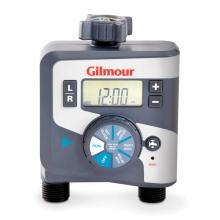What is an irrigation audit?
An irrigation audit is an essential lawn practice to evaluate the effectiveness of your lawn's in-ground sprinkler system. It checks for accuracy, uniformity, and leaks, to make sure you’re applying the right amount of water to the right spots in your yard.
Performing an irrigation audit can help keep your yard healthy, protect both water quality and quantity, and potentially reduce your water bill—a win for your lawn, the planet, and your wallet!
What tools do you need for an irrigation audit?
To perform an effective irrigation audit, you'll need the following key tools:
- Sprinkler gauges to measure the water output from each sprinkler head. You can purchase these or DIY with household items like tuna cans.
- Rain gauge to track the natural rainfall your lawn receives—this will come in handy to adjust your sprinkler system as needed.
- Ruler to measure the depth of water in each gauge.
- Calculator for calculating averages and uniformity of water application.
- Hardware tools like screwdrivers or wrenches for fixing or adjusting sprinkler heads.
- Notebook or digital device to record data and notes during the audit.
How to audit your irrigation system
Use your sprinkler gauges to audit your irrigation system using these steps:
- Run your irrigation system for 5-10 minutes to check for leaks, geysers, or broken heads.
- Repair or replace any broken or leaking pipes or sprinkler heads. Then rerun the system for a minute or two, to make sure everything is working properly.
- Adjust your sprinkler heads so you aren’t irrigating hardscape (driveways, sidewalks, patios, or decks). Save that water for where it’s really needed (like your lawn or garden) and protect water resources by reducing unnecessary water use and runoff.
- Place your sprinkler gauges at even intervals throughout a sprinkler zone.
- Run your irrigation system again, but this time for a full cycle of 30 minutes to measure application rate and uniformity.
- Calculate how much you are watering across each zone.
- Measure and record the location of each gauge and the depth of water in each gauge or can (if they aren’t marked, you can use a ruler!). Then, calculate the average application amount by adding all your depths together and dividing by the number of cans used.
- Calculate the uniformity of water application - this is the most complex calculation step.
- You’ll base this measurement on the lowest 25% of your measurements. To do this, you’ll need to determine how many cans makeup that 25% by multiplying the number of cans by 0.25. For example, if you used 20 cans, 25% of 20 cans is 5 cans.
- Now, take the average of the 25% of cans with the lowest measurements.
- Finally, divide the average measurements of the cans calculated in Step 7b by the overall average measurement of all cans. If your overall average application (calculated in step 6a) is 0.75 inches but your lowest 25% of cans are only catching 0.5 inches, your uniformity percentage is 0.5 divided by 0.75 = 0.67 or about 67% uniformity (which is pretty good!).
- Repeat steps 1-7 for each sprinkler zone in your lawn.
Importance of rain and sprinkler gauges to irrigation audits
Rain gauges are crucial for scheduling your irrigation by measuring the actual amount of rainfall your lawn receives, allowing you to adjust your irrigation accordingly. Together with sprinkler gauges, they help ensure that your lawn and garden receive the ideal amount of water—ideally about 1 inch per week from rainfall and irrigation combined. Sprinkler gauges also confirm that the right amount of water is reaching the right areas.
Adjusting your system after an irrigation audit
So you audited your system - now what? Use your measurements and new knowledge of your lawn to do the following:
Adjust for hydrozones
Hydrozones are areas within the lawn or garden that need different amounts of water than others. For example, low-lying areas or shaded areas typically need less water, while sloped areas might need a little extra. By identifying and adjusting your irrigation to suit these zones, you can provide the right amount of water to each area, preventing water waste and ensuring that plants are neither over- nor under-watered.

Rachio 3 Smart Sprinkler Controller, 16 Zone
- Measures moisture in your yard
- Save 30-50% on monthly watering bills
- No special tools or expertise needed to install
Adjust for uniformity
Within each hydrozone, it’s important to ensure water is applied uniformly. If the uniformity is below 60%, meaning some areas get too much water while others get too little, you should clean, adjust, or replace the sprinkler heads to improve uniform coverage.
Adjust for amount
Adjust your sprinklers to distribute between 1/3 and 1/2 inch of water per cycle. Calculate your irrigation rate by dividing the average amount of water collected by each gauge by 30 minutes.
Sunday Tip:
Math breakdown: Say you collect an average of 0.75 inches over a 30 minute period. 0.75 inches divided by 30 minutes = 0.025 inches per minute – this is your irrigation rate. If your goal is to only apply 0.5 inch per cycle, you want to reset your program to run for about 20 minutes (0.5 inch goal divided by 0.025 inch rate = 20 minutes) to ensure you aren’t overwatering

Gilmour Electronic Dual Outlet Watering Timer
- Easy to program watering start time, duration and frequency
- Rain Delay feature pauses schedule to avoid water waste
- Dual outlet allows you to run sprinklers with two hoses
Frequency of irrigation audits
The need to audit your irrigation system can vary based on climate, weather changes, water restrictions, and any signs of system issues like leaks or uneven watering.
We recommend conducting an irrigation audit each spring to prepare for the summer watering season. Additionally, performing routine checks during the season—especially in the fall—helps maintain system efficiency and address any problems as they arise.
Looking for additional ways to save some water? Pay attention to the weather and reduce watering if you get some rain or some cool weather, train your lawn to use less water, and if it’s allowed in your region, invest in a rain barrel to collect water for watering your lawn.
Cited sources
Auditing home lawn irrigation systems. University of Minnesota Extension.
No Miracle Cure for Drought. Utah State University Center for Water-Efficient Landscaping.
















